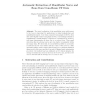Free Online Productivity Tools
i2Speak
i2Symbol
i2OCR
iTex2Img
iWeb2Print
iWeb2Shot
i2Type
iPdf2Split
iPdf2Merge
i2Bopomofo
i2Arabic
i2Style
i2Image
i2PDF
iLatex2Rtf
Sci2ools
MICCAI
2009
Springer
2009
Springer
Automatic Extraction of Mandibular Nerve and Bone from Cone-Beam CT Data
The exact localization of the mandibular nerve with respect to the bone is important for applications in dental implantology and maxillofacial surgery. Cone beam computed tomography (CBCT), often also called digital volume tomography (DVT), is increasingly utilized in maxillofacial or dental imaging. Compared to conventional CT, however, soft tissue discrimination is worse due to a reduced dose. Thus, small structures like the alveolar nerves are even harder recognizable within the image data. We show that it is nonetheless possible to accurately reconstruct the 3D bone surface and the course of the nerve in a fully automatic fashion, with a method that is based on a combined statistical shape model of the nerve and the bone and a Dijkstra-based optimization procedure. Our method has been validated on 106 clinical datasets: the average reconstruction error for the bone is 0.5 ? 0.1 mm, and the nerve
Beam Computed Tomography | Digital Volume Tomography | Mandibular Nerve | Medical Imaging | MICCAI 2009 |
| Added | 06 Nov 2009 |
| Updated | 15 Nov 2009 |
| Type | Conference |
| Year | 2009 |
| Where | MICCAI |
| Authors | Dagmar Kainmueller, Hans Lamecker, Heiko Seim, Max Zinser, Stefan Zachow |
Comments (0)

